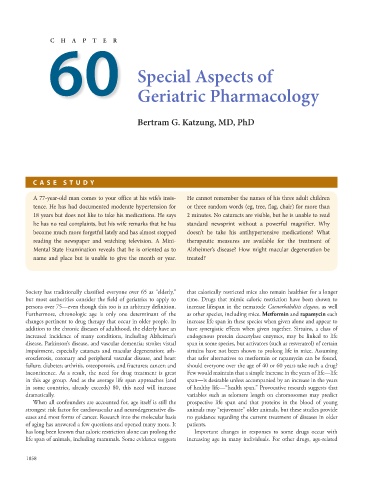Page 1072 - Basic _ Clinical Pharmacology ( PDFDrive )
P. 1072
60 Special Aspects of
A
H
C
E
R
P
T
Geriatric Pharmacology
Bertram G. Katzung, MD, PhD
C ASE STUD Y
A 77-year-old man comes to your office at his wife’s insis- He cannot remember the names of his three adult children
tence. He has had documented moderate hypertension for or three random words (eg, tree, flag, chair) for more than
18 years but does not like to take his medications. He says 2 minutes. No cataracts are visible, but he is unable to read
he has no real complaints, but his wife remarks that he has standard newsprint without a powerful magnifier. Why
become much more forgetful lately and has almost stopped doesn’t he take his antihypertensive medications? What
reading the newspaper and watching television. A Mini- therapeutic measures are available for the treatment of
Mental State Examination reveals that he is oriented as to Alzheimer’s disease? How might macular degeneration be
name and place but is unable to give the month or year. treated?
Society has traditionally classified everyone over 65 as “elderly,” that calorically restricted mice also remain healthier for a longer
but most authorities consider the field of geriatrics to apply to time. Drugs that mimic caloric restriction have been shown to
persons over 75—even though this too is an arbitrary definition. increase lifespan in the nematode Caenorhabditis elegans, as well
Furthermore, chronologic age is only one determinant of the as other species, including mice. Metformin and rapamycin each
changes pertinent to drug therapy that occur in older people. In increase life span in these species when given alone and appear to
addition to the chronic diseases of adulthood, the elderly have an have synergistic effects when given together. Sirtuins, a class of
increased incidence of many conditions, including Alzheimer’s endogenous protein deacetylase enzymes, may be linked to life
disease, Parkinson’s disease, and vascular dementia; stroke; visual span in some species, but activators (such as resveratrol) of certain
impairment, especially cataracts and macular degeneration; ath- sirtuins have not been shown to prolong life in mice. Assuming
erosclerosis, coronary and peripheral vascular disease, and heart that safer alternatives to metformin or rapamycin can be found,
failure; diabetes; arthritis, osteoporosis, and fractures; cancer; and should everyone over the age of 40 or 60 years take such a drug?
incontinence. As a result, the need for drug treatment is great Few would maintain that a simple increase in the years of life—life
in this age group. And as the average life span approaches (and span—is desirable unless accompanied by an increase in the years
in some countries, already exceeds) 80, this need will increase of healthy life—“health span.” Provocative research suggests that
dramatically. variables such as telomere length on chromosomes may predict
When all confounders are accounted for, age itself is still the prospective life span and that proteins in the blood of young
strongest risk factor for cardiovascular and neurodegenerative dis- animals may “rejuvenate” older animals, but these studies provide
eases and most forms of cancer. Research into the molecular basis no guidance regarding the current treatment of diseases in older
of aging has answered a few questions and opened many more. It patients.
has long been known that caloric restriction alone can prolong the Important changes in responses to some drugs occur with
life span of animals, including mammals. Some evidence suggests increasing age in many individuals. For other drugs, age-related
1058

